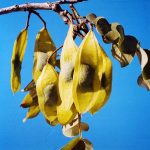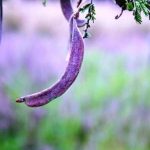TREE LIFE
September 2002
AS BEFORE PLEASE CONFIRM WITH ANY OF THE COMMITTEE MEMBERS THAT THE SCHEDULED OUTINGS AND WALKS WILL ACTUALLY TAKE PLACE. SEE THE BACK PAGE FOR PHONE NUMBERS.
MASHONALAND CALENDAR
Saturday 7th September. Botanic Garden Walk. Meet in the car park at 10.45 for 11 a.m. where we will gather for another informal walk in the garden.
Sunday 15th September. This month Eva has arranged our visit to Irvine’s Game Park in Harare South. This new venue is close to town, and we would like to thank Irvine’s for allowing us free access. Meet at 9.30 a.m. with your lunch and a chair.
Saturday 21st September. Please note that Mark’s next walk is brought forward a week because of the EHTE trip. Our host’s names are: Dieuwie and Piet Holthuysen and they live at 2153 Highgate Close, Glen Lorne.
Tuesday 1st October. Botanic Garden Walks move back to Tuesday evenings now that the warmer weather is with us again, and we hope Tom will be refreshed after his holiday.
MATABELELAND CALENDAR
Nothing has been arranged for September.
TOM RAUBE REMEMBERED
Sunday June 7th 1992. Diary entry from Margaret McCausland. Cold, windy and overcast. To the Wood’s place – Glen Curragh Farm, Nyamandhlovu. The Blakes, Peta, Geoff Archer, Angela and Charles Sykes, Angela Murray, Clem van Vleit and her daughter Gill, Joy Kets ….and an American couple – Mary and Roy Raube. Left the Falls Road Motors at 8.45 a.m.
I still remember the damp morning and the Raubes arrival in their white Merc. It was the beginning of a decade-long association and many of the names on the diary list who are still living will have fond memories of Roy a.k.a. Tom Raube. His wife, Mary, always called him Tom and thus he was known to all the Tree People of Bulawayo and Harare.
Tom Raube, like ‘all’ Texans, was a large man. Large in frame and large in personality. Two activities had absorbed his working life – Orthopaedics and ‘hunning’. As a specialist surgeon he practiced in Bluefield, West Virginia, the state where he met and married Mary, a trained nurse, who thereafter worked in his practice. He was enormously successful in his chosen profession and his relentless work habits laid the foundation and set up the resources which allowed him to indulge a well-earned retirement. In the few weeks each year away from scalpel, green gown and theatre, he unwound with ‘hunning’. Like Hemmingway, he had shot all the big mammals, but in his case, on all the continents. Thus he came to Africa.
I never really found out just why he settled in Bulawayo, but his dream, I think, was to have his own safari ‘outfit’, but by this time he had largely put away his guns. I think he only went on one hunt after I had got to know him because by now his attention and obsessions had taken a new track and it was a spoor that he followed as relentlessly as once he might have pursued a wounded animal. The new quarry was botany. But at first it was trees.
By Easter 1993 we had got to know the Raubes well enough to share accommodation during the Society’s memorable trip to Inyanga. Bob Drummond was billeted with us too. Tom was captivated by Bob’s encyclopaedic knowledge of the local flora and his fascination attained hero worship status the night Bob went astray on the way down from Rukotso and wandered in after 10.00 p.m., dragging his yellow cement sack full of botanical souvenirs. A friendship was founded and Tom always called on Bob when he was in Harare.
To say that Tom’s appetite for botanical knowledge was voracious was a gross understatement. He went everywhere – the Matopos, Buchwa, Chimanimani, Bulawayo greenbelt, the Circular Drive. And he dogged any person with expertise – Charles Sykes, Anton Ellert, Geoff Archer, and of course, Bob Drummond. Many became close friends and he was always very fond of the Tree people saying, “D’ya know, you’re the only folk in this country who are not after my money!” His collecting was obsessive and the interior of his 4×4 at times resembled a wheeled compost heap. In his path no thing of beauty was left unplucked and no National Park immune from his harvesting. His knowledge not only of trees, but of the smaller things too, grew formidably. He brought his binocular microscope from the States to look into the hearts of the tiny flowers he loved to collect and he sketched these specimens carefully and sensitively.
In January 1994 the Raubes hosted the annual New Year’s day gathering for the Tree Society at their lovely home in Kumalo. It was our first encounter with the generous Raube hospitality and many more were to follow in the years to come, not only in Kumalo, but at Kana East and at Malindi. The latter two were Tom’s dreams come true – the safari outfits in Matabeleland North which became the reality of his retirement. The Tree Society people know both well, but more particularly Kana East the exciting property on the escarpment overlooking the Shangani Valley. In recent years Tom spent much of his time here.
He was one of the most extraordinary men I have known and in knowing Tom Raube, that is if you could ever get to know this energetic, restless, controversial and questing person, was quite simply reward enough. I know that the likes of him will not pass this way again and I will miss him.
In fond memory.
-Ian McCausland
MAURITIUS
As I sank into the luxury of colour and spectacle on the island of Mauritius, I became aware of the wonderful woven lives of the people and plants in this tropical environment. The island reflects the various early occupations of peoples and their plants with representations from Africa, Asia, Europe, Australia, and the Americas. Although the mountain gorges are home to indigenous flora and fauna, the lower plains are a patchwork of sugar cane (Saccharum officinarum) separated by narrow roads and strewn with colourful lively villages. The hillsides are matted with Travellers’ Palm (Ravenala madagascariensis), and Chinese guava (Psidium cattleianum) and on weekends the tangled pathways are filled with noisy children filling their bags with the delicious pink fruit. I found it difficult finding anyone who could discuss the vegetation until I met the wonderful groundsman of the Shandrani Hotel. I was able to enjoy a two-hour tree walk through the extensive grounds and admire the Madagascar palm (Phoenix dactylifera), the Royal Palm (Roystenea regia) and many others, all of which he germinates himself in his nursery. He has given me the list of trees and plants for anyone else who may visit Mauritius and I have given it to Mark Hyde. It is always a treat being shown around a well-loved and dynamic park such as this one. Hopefully I shall one day revisit this enchanting island of colour and sun.
Judy Wienand.
In Retrospect (Continued) Lyn Mullin
LONG-CRESTED EAGLE AND ST JOHN’S WORT
A delightful little anecdote, under this heading, was contributed from the Nyarupinda Catchment in TREE LIFE No. 138 (August 1991):
The Evangelist, John, is symbolized by an eagle.
On July 5th a Long-crested Eagle watched for prey in a moist vlei where Hypericum roeperianum is coming into flower. This happened on the day we remembered to change the pictorial calendar to July – a Long-crested Eagle.
Mr HM Biegel, a keen collector of indigenous plants, who wrote the text of Rhodesian Wild Flowers, says that the name of the genus Hypericum comes from the Greek words [for] `above’ and `picture’. This referred to an old custom of placing flowers above images of Saint John on his feast day to ward off evil. There is a legend that the devil took revenge – he stabbed the leaves with a needle. Hand-lens inspection of the plant shows that he also left a trail of black spoor on the margins of the leaves, and a scattering on the petals. Hypericum roeperianum has tiny translucent dots in the leaves, and there are black glands on the leaf margins and on the petals – what a revelation! Unfortunately, the shorter, twiggy, cultivated species lack the black markings, thus there is an obligation to find the wild one whilst it is still in bloom.
[Comment 2000: Wort (pronounced wert or wurt) is so often mispronounced as wart in Zimbabwe that it might be helpful to know that the word was derived from the Old English wyrt, meaning root, and was usually applied to plants that were formerly used to cure diseases, e.g. liverwort, spleenwort. According to E Cobham Brewer (1906), Dictionary of Phrase and Fable, the spleen was once believed to be the seat of ill-humour and melancholy, and the herb, spleenwort (Asplenium), was supposed to remove the disorders. Presumably liverish people were treated with liverwort (Hepatica/Anemone).]
THE GONAREZHOU EXPEDITION
For those who took part in the expedition to Gonarezhou National Park in August 1985, the event probably stands out as one of the highlights of the Tree Society’s entire existence. At any rate, it generated a bumper edition of TREE LIFE in September 1985, taking up a bit under 9 of the 14 pages of that issue (No. 67), and a further half page in TREE LIFE No. 68 (October 1985).
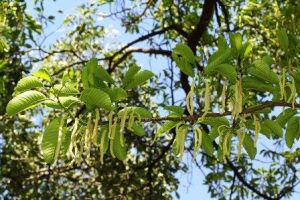
Milicia excelsa. Photo:Bart Wursten. Source: Flora of Zimbabwe
It would be too much to try to reproduce the whole of the report on the Gonarezhou expedition in this series of extracts from earlier issues of TREE LIFE, but it does contain a very interesting discussion by Kim Damstra on the long-term survival of the small population of Milicia excelsa (formerly Chlorophora excelsa) at Nyahungwe on the Runde River, one of only two such populations in Zimbabwe. This discussion is reproduced in full:
Fishan, itself, is situated in a grove of Xanthocercis zambesiaca, from which one looks eastwards down the wide riverbed towards the orange sandstone of the Chilojo Cliffs (= Clarendon Cliffs). The cliffs deflect the river northwards, and back to the contact zone between granophyre and Cretaceous sandstone. Where it leaves the granophyre upstream from Fishan, both banks consist of sands deposited by the river in the geologically recent past. By the time the river has returned to the contact zone, just before Nyahungwe Camp, it is separated from the sandstone of the Chilojo Cliffs by a wide floodplain of alluvial sand, which is now 10 metres or more above the present riverbed. Besides having eroded down to this new level, the river has obviously changed its course often in this area. At some stage Fishan was the riverbed itself, and the twisted formation of the Nyavasikana mouth implies a recent development of this extension. North and northeast of Chilojo Camp, the drainage lines all run parallel, and not perpendicular, to the river itself. Downstream of Nyahungwe the Pombadzi River flows in a more recently abandoned channel of the Runde. Why is this geology important? Because it changes one’s outlook on the small population of Milicia excelsa, which finds a precarious foothold on the narrow river bank near Nyahungwe Camp. I had mistakenly thought the Milicia were threatened by the erosion of the Chilojo Cliffs themselves, instead of being threatened by the erosion of the alluvial riverbanks. What is the difference? Just imagine a unique soil type, for example, that only existed on the edge of the Chilojo Cliffs. When this habitat eroded away, the population on this soil would be lost, but more importantly we would mourn the loss of the habitat. In contrast, if a plant species grew only on the steep cliff-face, then when that face was eroded away, part of the population may be lost, but a new cliff-face would be created, and the habitat, thus, not destroyed. Assuming the Runde River is not becoming wider (i.e. changing into a vlei area), as it moves around the floodplain it does not destroy the alluvial habitat. The problem is thus not one of trying to protect the habitat, which is continuously recreated, but rather to ensure that the regeneration rate equals, or exceeds, destruction.
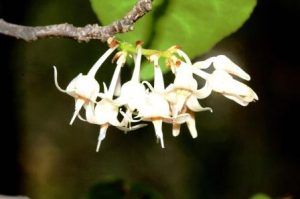
Rinorea elliptica. Photo: Bart Wursten. Source: Flora of Zimbabwe
What has happened to regeneration? It appears that the heavy game pressure on the river fringe has changed the vegetation markedly. The specimens of Rinorea elliptica beneath the Milicia are heavily browsed, and the undergrowth is well trampled. One wonders if there is much chance of a seedling surviving such high pressure. In addition, if this was once a thick riverine fringe forest, then the seedlings would germinate on the forest floor under moister, cooler conditions than those that now prevail. Milicia are also male and female trees, so of the eight trees now present along Nyahungwe, on average only four will produce seed. The only tree we discovered in flower had catkins longer than 4 cm, and was thus probably male. The sex ratio of the remnant population still needs to be determined – this could be done in the next month if someone would return to them. If they are all male, then the population is doomed anyway – it is simply a matter of how long it takes. The faster erosion rate that is reported could also be attributed to damage of the riverine fringe. Once again, the problem returns to overstocking of game, and the necessity to cull – particularly the elephant, which are such destructive feeders. National Parks is well aware of this problem. The tragedy of the Milicia does not, therefore, lie in their being eroded into the Runde, but rather in the loss of the riverine fringe forest due to game pressure. This problem could be overcome either by drastically reducing the game population, or excluding them from local patches at the riverine fringe. At present, the latter seems impossible.
[Comment 2000: According to a dictionary definition, granophyre is a fine-grained granitic rock in which irregular crystals of intergrown quartz and feldspar are embedded in a groundmass of these minerals.Measurements of height and diameter made on the Milicia at Nyahungwe in 1986 suggested two distinct age classes, the older with diameters ranging from 143 to 197 cm, and heights from 24 to 34 m, and the younger with diameters ranging from 74 to 99 cm, and heights from 16 to 23 m. If this supposition is correct, one might assume that the younger are the progeny of the older trees, which suggests that male and female trees are present, at least among the older age class. Browsing pressure by game is undoubtedly responsible for the absence of seedling regeneration today, but how long has this been the controlling factor? Presumably since Gonarezhou became a national park in the late 1950s or early 1960s, so what happened before then? According to Dale and Greenway (1961), Kenya Trees and Shrubs, young Milicia excelsa may be heavily browsed by game, but it is difficult to feel completely comfortable with the postulation that game are responsible for the total absence of regeneration, going back decades before the creation of the national park. To judge from the sizes of the larger trees, they must be several hundred years old by now, and should have been regenerating. What of the other small population of Milicia at the Haroni-Rusitu junction in the Chimanimani/Chipinge area? Is it regenerating? Perhaps some intensive research into the status of these two populations is needed for a thorough understanding of what is happening now, and what is likely to have happened in the past, so that some kind of action can be taken to prevent their extinction.]
To be continued.
TREES AND BEES by Peter Taylor
At the Tree Society outing to Sanganayi on Sunday 21 July 2002, very little was seen in the way of flowering trees of use to honey bees. In fact, only one shrub useful to bees, Vernonia colorata, was seen in flower. Ormocarpum kirkii was seen, which had just finished flowering and fruit was starting develop. This is an attractive tree for honey bees. One other flowering shrub seen, Senna singueana, is of no use to bees and they never visit it.
This time of the year is a pretty lean period for bees, with little or no food available to them, and the reason they store honey and pollen is to tide them over this period of dearth.
Other trees in flower at this time of the year, which we didn’t see on this outing, are Dombeya rotundifolia and Erythrina sp., which, had we looked for them, we would probably have found.
Erythrina attracting bees is interesting as bees are unable to detect red. Possibly these flowers are not true red and the light waves are a little longer than red, tending towards orange. As bees can detect ultra violet, maybe Erythrina flowers have ultra violet nectar guides invisible to us.
One musasa was seen with new spring foliage and, within the next week or so, this tree will be in flower. Musasa is a major source of nectar for honey bees.
PARASITES OF INDIGENOUS TREES
The outing to Sanganayi creek at Mazvikadei near Banket, aroused interest in various topics. Very evident were the parasites on the Leguminosae which were Pilostyles aethiopica and Loranthus.
Names have changed and Pilostyles aethiopica is now Berlinianche aethiopica. and the Loranthus we saw is now renamed Plicosepalus kalahariensis. It is a parasite of Acacia karroo and Acacia nilotica.
Berlinianche (Pilostyles)
Meg Coates Palgrave stimulated my interest in Berlinianche. It was at a walk in the Mukuvisi woodlands some years ago that my curiosity was aroused by this peculiar little plant.
Dead twigs and whole branches of the Munondo are blackened and have tiny little wooden cups along their length resembling spots, or a bad case of tree acne, and are a little reminiscent of the seed capsules of the common bottle brush.
There are no sepals or petals or any leaves, just numerous little horny cups. Berlinianche is found 95% or more on Julbernardia, the Munondo, and is found only in Miombo Woodland. The parasite is almost a diagnostic feature of Julbernardia.
Meg was in the herbarium and looking through a volume of Flora of Tropical East Africa and came across Rafflesiaceae and wondered if Flora Zambesiaca had covered that family yet.
It occurs in Zimbabwe, Zambia, Malawi and Tanzania, Gabon, Angola and Zaire. Although both Floras say parasitising species of Berlinia, Brachystegia, Isoberlinia and Julbernardia, I stick to my contention that in Zimbabwe they are most often found on Julbernardia.
Meg, quoting Visser (Johann Visser (1981) South African Parasitic Flowering Plants, and adding her own observations writes; “The South African representatives of this family (Rafflesiaceae) are all root parasites (of course they do not have Julbernardia there) whereas other genera may grow on, or rather within the stems of various trees. Considerable endophytic development of the parasite inside the host’s tissue is claimed to cause extensive invasion to the host and to precede the production of flowers – the only part of the parasite ever to protrude from the host. Being dioecious, male and female plants usually invade separate host individuals. That I can confirm. There was a lad from Switzerland here about 18 months ago and I took him and Tom Muller to the Mukuvisi and we were able to find both male and female flowers. In the Botanical Garden they had found only one sex.”
FZ says the perianth is in two whorls of 5-6 segments, purple-red, more or less fleshy. It also says herbarium specimens with male flowers appear to be far more common than those with female flowers.
I am sure that this is a true reflection but could well be coincidental.
The red-purple colour in the perianth cup is the fused sepals and petals and is referred to as the perianth by Visser and Mabberly (Mabberly DJ (1997) The Plant- Book.
Having observed busy little black ants stamping all over the ‘cups’, it was queried if they might be the pollinators. Meg continued her argument:
“Although Visser mentions the strong probability of the genus Cytinus in South Africa being pollinated by ants, I think it extremely unlikely that our Berlinianche is, for two reasons. One, the male and female flowers were fairly far apart. We would find a patch with one sex and then had to search for a patch of the other sex. I think it unlikely that ants would travel that distance. Secondly the bright red/pink is a colour that attracts birds”.
Has anyone observed birds visiting Berlinianche?
The FZ describes the fruit as a globose berry surrounded by persistent bracts and perianth segments. A very likely candidate for dispersal by birds. Lyn Mullin, quoting Mabberley on the mistletoes (Viscaceae), writes “the fruit of many parasitic plants is eaten by birds, but the viscid tissue on the seed prevents the seed from being swallowed, and the bird scrapes it off into bark crevices, etc. where it germinates”.
A reference was made to mistletoe by Lyndsay Mullin with a reference from Roberts (1985 ed.) Birds of Southern Africa, Yellow-fronted Tinker Barbets have a particular preference for mistletoe fruit, but I am sure other fruit-eating birds will also take this fruit. The sunbirds are recorded as feeding on the nectar of the mistletoes but I see nothing about them eating the fruit.
On asking how destructive the parasite was, Meg referred to the extensive invasion into the host, but she had only noticed twigs and branches dead. “It would be self-defeating to kill the host plant, wouldn’t it?”
Lyn Mullin writes, “a hemiparasite is a parasitic plant that carries out photosynthesis, but also obtains food from its host. By definition, the haustorium of a parasitic plant does enter the vascular system of the host, but I suspect that only rarely will a host be so heavily parasitized that it will die. The parasite would naturally die with the host, so I suspect that nature takes care of that by limiting the number of parasites on any one host – but I don’t know!”
On walking through the Mukuvisi, I noticed trees with parasitized branches being cut down by tree cutters and the trees appeared dead. The death of the entire tree may not have been caused by the parasite but rather to opportunistic Homo sapiens looking for wood.
Perhaps, if these trees that have been hacked down under the pretext of gathering dead wood are examined and found to coppice, then the parasite has not totally destroyed the parent tree. Have readers any explanations or observations?
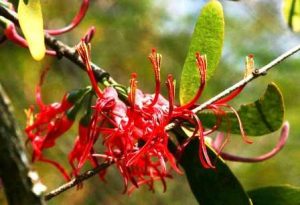
Plicosepalus kalachariensis (Loranthus). Photo: Bart Wursten. Source: Flora of Zimbabwe
At the visit to Sanganayi Creek this July, the Loranthaceae were spectacular as they hung to advantage from branches of trees that had dropped their leaves during the cold winter period. The pretty pink, corals and reds looked like bunches of honey suckle. The stems are referred to as dichasial. A dichasium is a type of inflorescence in which each branch of the inflorescence gives rise to two other branches.
Mabberley describes the flowers as usually bisexual, usually regular, conspicuous and frequently red or yellow, insect-or bird-pollinated, in dichasia sometimes resembling heads, racemes, umbels, etc.
A few weeks later, when walking through Ewanrigg Botanical Garden, the flowers of the Loranthaceae were not open but sticking out like little pink tubes with a dark purple cap. Ewanrigg is colder than Sanganayi Creek and the flowers were not at the same advanced stage. If insect pollinated, and certain species of butterfly are specific to species of Loranthus, then these pollinators would not be active and may not have emerged from their pupal form. Meg, when asked about the pollinating mechanism, quotes Johann Visser; “Explosive anthesis has been developed to a high degree of perfection in this family. As the bud matures the corolla lobes become more turgid and strain outwards but are firmly held together at the margins. Then at the slightest touch the corolla lobes separate explosively outwards. Simultaneously, the filaments inflex or recurve sharply, thus releasing a cloud of pollen – in this way dusting the forehead of the pollinator. The style usually snaps to one side, apparently to prevent self-pollination, but also ensuring that the pollen from the forehead of the visitor is smeared onto the sticky stigma”.
Although the caption to one of the pictures says: ‘In their attempts to extract nectar, sunbirds slit open the corolla tube of Tapinanthus rubromarginata’ – and so perhaps they are the pollinators. Mabberley begins his description of the family Loranthaceae as follows:
“Photosynthetic hemiparasites, typically brittle shrublets or tree branches, less often terrestrial shrubs, lianes or even trees on host roots.
The hemiparasites would be less likely to destroy the host unless present in great numbers. Berlinianche without leaves and relying on the host for total nutrients could be more destructive.
Perhaps we should be stimulated to look at little less at trees but to observe what is on trees and how trees interact with the rest of the ecological system. There is the old expression not to see the wood for the trees and we tend to only see trees.
-Mary Toet
I found this fascinating and, at this point, topical snippet in the January 1995 issue of BBC Wildlife Magazine.
“If you find a mistletoe growing on a host tree on a warm summer day, feel the leaves of the host tree. Like all healthily functioning foliage, they will be quite cool to the touch, but those of the mistletoe will be appreciably colder. This is because the mistletoe, being a parasite tapped into the vessels of its host, is evaporating water at a greater rate. If it didn’t then the host would quickly suck it dry and the mistletoe would collapse and die.”
M S-J
THE BELHAMBRA AT MTAO FOREST
Does very well here, but apart from being a good shade tree, it is useless; must not be planted near buildings on account of its large surface roots.
W.E. DOWSETT (1918)
REPORT ON EXPERIMENTAL FORESTRY AT THE RHODES ESTATE, MATOPOS
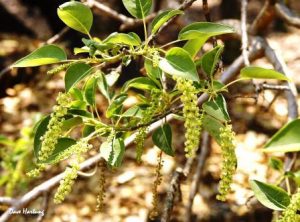
Phytolacca dioica. Photo: Bart Wursten. Source: Flora of Zimbabwe
The Belhambra, Phytolacca dioica (Phytolaccaceae) is something of a botanical freak – a rare tree species in a family of herbs and shrubs. It comes from Argentina, Brazil, and Paraguay, and was introduced into Zimbabwe as a good fodder tree, probably before 1910. But Dowsett’s report, which was published in Volume 15 of The Rhodesia Agricultural Journal, made no mention of its supposed fodder value. In South America it is used for shade.
The name Belhambra seems to be a corruption of the Spanish bella sombre or belombra, by which it is known in South America, but whether this corruption is confined to southern Africa is not known – the name does not appear in JC Willis’s Dictionary of Flowering Plants and Ferns, or in DJ Mabberley’s The Plant Book.
Belhambra is typically a wide spreading tree with a short, thick trunk, but its best-known characteristic is the massive root system that covers a considerable area on the surface round the tree, often giving the tree the appearance of growing on top of a large black rock. It is this root development that discourages the planting of Belhambra in any but the largest gardens.
The largest-known Belhambra in Zimbabwe stood at Mtao Forest, a little more than 10 kilometres south of Mvuma, and only 100 metres or so off the main highway to Masvingo. It was planted in the 1920s, significantly outside the grounds of the Estate Manager’s house! In March 1988 it was 15 metres tall, with a trunk diameter of 1.08 metres and a crown spread of 22 metres – the crown was actually touching the ground almost all the way round. The visible root system had a perimeter of 23 metres (diameter 7.3 metres), which means that these roots – never mind all those below the surface – occupied an area of 13 square metres. Hardly the sort of tree you would want in your town garden! But in 1991 the whole tree simply collapsed, possibly because its branches had become unsustainably heavy. This leaves three other living Belhambra trees known to me in Zimbabwe: one at the Harare Forest Nursery in Highlands, Harare; one at Devuli Ranch headquarters in the Save Valley (the original developers of this property, the Bridges family, had lived in Argentina before coming to Zimbabwe in the 1920s); and one at the corner of Herbert Chitepo (Rhodes) Avenue and Fifth Street – this last has historical connections with Andrew Milroy Fleming, the medical doctor who gave 50 dedicated years of his life to the public health system of Zimbabwe. I am sure there are other Belhambra trees still around, but the species is no longer as popular as it once was.
-Lyn Mullin
QAT, KHAT OR SIMPLY CATHA EDULIS
On one of the recent Botanic Garden Walks we got to discussing the supposed effects of chewing the leaves of Qat, or Catha edulis, which we know so well in Zimbabwe. No-one present had experienced any feeling of well-being after munching a leaf and a little research has revealed that perhaps we got it all wrong, expecting too much too soon.
An extract from a very interesting book entitled People’s Plants, by Ben-Erik van Wyk and Nigel Gericke, provides the following information.
“Catha edulis (Celastraceae) – ‘Khat’ (Arabic): or ‘Bushman’s tea’ in parts of South Africa.”
This small to medium-sized tree is widely distributed along the eastern parts of southern Africa, and further north to east Africa and South Yemen. The use of Catha edulis as a stimulant has been well described in east Africa and in Yemen, but it is not generally known that the plant is used in much the same way in parts of South Africa. The fresh young leaves and adjacent soft stems are chewed for the energy and endurance they give the user, and for freedom from hunger and fatigue during strenuous work and walking in mountainous terrain. The slightly bitter and astringent leaves are chewed and the resulting juices swallowed. A sweet, liquorice-like aftertaste remains, accompanied by thirst. To the uninitiated, the stimulant effects are not immediately apparent, but with experience the unique psychotropic signature of the plant can be appreciated, including remarkable clarity of thought, alertness, a sense of well-being and increased sociability. Some South African users report that chewing fresh leaves was originally learned from hunter-gatherers. There is some evidence in the literature supporting this. The common English name is bushman’s tea, and tea is still occasionally brewed from the leaves.
The fresh leaves are chewed, or an infusion of the leaves is taken orally for colds and ‘flu, coughs, asthma, to assist in losing weight and for menstrual cramps. Cold water infusions of the roots or bark are taken for diarrhoea and dysentery, and a root infusion is taken orally for male infertility, and to treat boils.
The stimulating effect of the fresh leaves is due to several phenethylamines, including cathinone which has amphetamine-like properties. Since cathinone is unstable, the preference for the use of fresh leaves can be understood. Prior to the isolation and identification of cathinone, it was believed that cathine (D-norpseudoephedrine), first isolated from khat in 1930, was the active principle. A synthetic salt is widely used as an over-the counter appetite suppressant.
Side-effects of habitual use reported in the literature from Ethiopia, Somalia and Yemen, include the potential for the development of aggressive and paranoid behaviour, personality problems, hypertension, insomnia, constipation, low libido, emaciation and debilitating effects on family budgets. The incidence of these adverse phenomena, if indeed they occur in southern Africa, is unknown.
Cathinone has recently been added to the schedule of illicit drugs in the USA, and fresh Catha edulis itself is sold on the black market in the USA for about $30 a handful. The use of the plant in the USA is believed to be a result of the exposure of soldiers to khat during the U.S. military involvement in Somalia, where the plant is widely used as a stimulant.”
Rootnote: from John Lawrence.
The following quotation from Carr may be a comfort to members.
“Botany is the art of insulting flowers in Greek and Latin.”
MARK HYDE, CHAIRMAN


